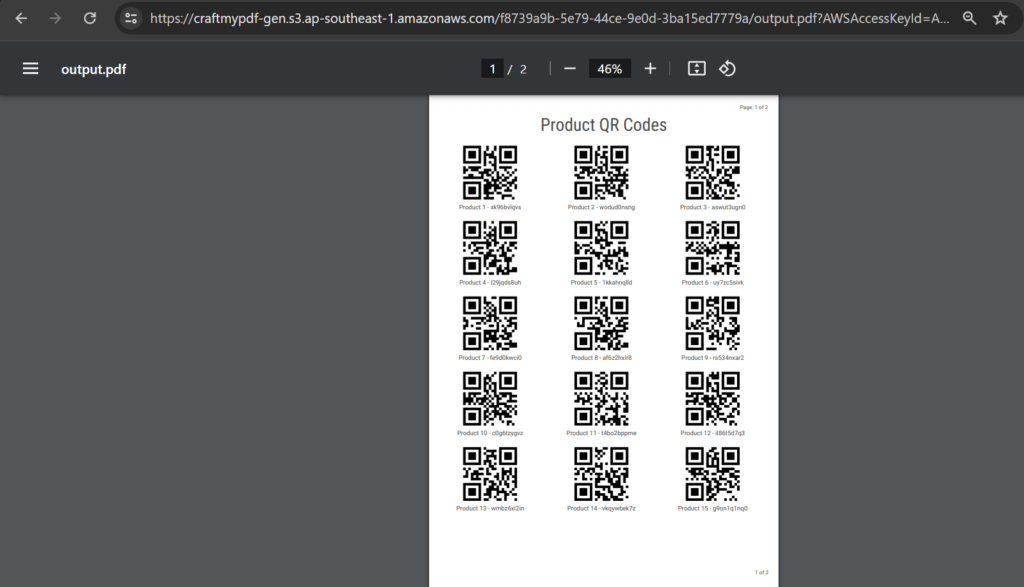Have you ever picked up an item and noticed those mysterious black-and-white lines printed on it? Perhaps you’ve wondered what they meant.
Those are barcodes! Barcodes are like secret messages that only machines can read. Each line represents a different letter, cleverly arranged so that when a scanner reads it, it instantly knows what product it’s scanning. It’s almost as if the barcode is whispering to the scanner, saying, “Hey, I’m a can of beans!” or “Yo, I’m a bag of chips!”

Now, let’s spice things up with QR codes! QR stands for Quick Response, and these codes are like the fancy cousins of barcodes. Instead of lines, QR codes look like pixelated squares arranged in a grid. They’re like tiny mosaics of information!
What makes QR codes super cool is that they can hold a lot more information than regular barcodes. It’s like they’re the VIP section of the code world. You can scan a QR code with your phone, which can lead you to a website, share contact info, or even unlock hidden treasures (okay, not treasures, but you get the idea).
In this article, we’ll explore barcodes and QR codes, discussing their applications and how they’re used in various scenarios. I’ll guide you through the steps to create these codes using Python and Node.js.
Additionally, we’ll look at how to generate barcodes and QR codes with CraftMyPDF, which supports REST API and integrates seamlessly with no-code platforms like Zapier, Make.com, and Bubble. So, let’s dive right in!
1. Understanding Barcodes and QRCodes
1.1 Barcodes
A barcode is made up of a series of black and white lines of varying thickness and spacing. These lines represent different numbers or characters, all carefully arranged to convey specific information.
When a barcode scanner scans the barcode, it reads these lines and translates them into useful data. Barcodes encode data by varying the widths and spacings of the bars. This encoding can be numeric, alphanumeric, or even binary, depending on the type of barcode.
There are various types of barcodes, each with its own unique structure and encoding method. Some common types include UPC (Universal Product Code), EAN (European Article Number), Code 39, Code 128, and more.
Barcodes may also include a checksum digit, which is a mathematical formula applied to the data to ensure accuracy. This digit helps detect errors in scanning or data entry. Barcodes are useful in various industries, including retail, manufacturing, logistics, healthcare, and more.
They enable efficient inventory management, track products through supply chains, expedite checkout processes, and facilitate data capture in countless other scenarios.
1.2 QR codes
Quick Response codes (QR codes) are a type of barcode. They consist of square grids composed of black squares arranged against a white background. These squares create patterns that encode information.
Unlike traditional barcodes which use varying line thickness and spacing, QR codes use a grid-based pattern. This allows for information to be encoded both horizontally and vertically, enabling QR codes to store significantly more data than conventional barcodes.
One of the coolest features of QR codes is their ability to withstand damage. They have built-in error correction capabilities, meaning even if part of the code gets smudged or damaged, a scanner can still read it and recover the information. QR codes aren’t just for product labels.
They’re used everywhere, from advertising and marketing to ticketing, payment systems, and even Wi-Fi network authentication. You can even generate QR codes to share contact information, URLs, or Wi-Fi passwords.
To read a QR code, you simply need a smartphone or a QR code scanner. Just point your device’s camera at the code, and it will instantly decode the information and take you to the intended destination.
1.3 Exploring the similarities: Barcodes vs QR codes
Barcodes and QR codes have certain similarities, some of which are:
- Both barcodes and QR codes encode information that scanners or mobile devices can read to access details regarding products.
- Barcodes and QR codes are user-friendly and can be scanned using handheld scanners or smartphone cameras
- Barcodes and QR codes are convenient for use in various applications.
- Both barcodes and QR codes provide quick access to information.
- They both enable consumers to access product details, promotions, event tickets, payment options, and other relevant content with minimal effort.
1.4 Comparing the differences: Barcodes vs QR Codes
While both barcodes and QR codes share certain similarities, there are still some notable differences between them, such as:
- Barcodes are typically composed of parallel lines of different sizes and spaces, while QR codes are like little black squares arranged in a grid.
- QR codes are super flexible compared to barcodes and have way more uses than just labeling products. People use them all over the place for advertising, ticketing, and even paying for stuff.
- Barcodes convey data through changes in line thickness and spacing, whereas QR codes utilize a grid structure to encode data in both horizontal and vertical directions, enabling them to accommodate larger amounts of information.
- QR codes can store more data due to their grid-based nature compared to barcodes.
- QR codes also offer faster and more accurate scanning due to their grid-based structure
1.5 Common uses of Barcode
Barcodes are everywhere. They have transformed the way we interact with technology in our daily lives. Here are some of the common uses of barcode:
- Retail industry: Barcodes have changed the game in retail industries. They help in tracking product information. From your grocery items to your books, to you name it. This helps make shopping faster and more efficient.
- Logistics management: Barcodes play a vital role in the logistics industry. They help in tracking shipments to ensure the smooth delivery of goods from sellers to buyers.
- Healthcare industry: Barcodes are used in the healthcare industry. Yes, healthcare! They help track specimens, medications, and all of the medical equipment you can think of. This helps reduce errors and increase efficiency.
- Manufacturing industry: Barcodes are used in the manufacturing industry for product identification and in tracking raw materials and finished products throughout the production process.
1.6 Common uses of QR code
QR codes are popularly used in some of the major industries. Here are some common uses of QR code:
- Advertising industry: QR codes are popularly used in advertisements to provide interactive content, promotions, and additional information to consumers. With just a simple scan, they can direct users to websites, videos, social media profiles, or promotional offers.
- Ticketing process: QR codes simplify ticketing processes for events, concerts, movies, and so on. Attendees can easily scan QR codes on their smartphones to access digital tickets, boarding passes, or event registrations, eliminating the need for physical tickets. You can also auto-generate PDF tickets with CraftMyPDF. For more information on how to do this, check out our existing tutorial.
- Content sharing: QR codes are used to share valuable content such as contact information, URLs, WiFi credentials, and so much more. This enhances connectivity and sharing of information.
- Payment Integration systems: QR codes can be used in payment integration systems. This is an easy way for making payments using smartphones or computers. Users can scan QR codes displayed at checkout counters or on invoices to complete transactions securely and efficiently.
2. Open-source for QRCodes and BarCodes
Node.js and Python have existing open-source libraries that you can take advantage of to generate barcodes and QR codes. Here’s a list of some of the popular open-source libraries available in Node.js and Python.
2.1 Open Source Node.js Libraries
i. BWIP-JS
bwip-js (Barcode Writer in Pure JavaScript): bwip-js is a native barcode generator that renders barcodes using JavaScript and HTML5 Canvas. It supports over 100 barcode formats including QR codes, Code 128, EAN, and more. You can install the library via npm, and then use its API to generate barcode images directly in your Node.js application. You can also customize the barcode’s data, format, size, and appearance.
ii. JsBarcode
JsBarcode: JsBarcode is a powerful open-source library that enables developers to generate various barcode formats such as CODE128, EAN, QR codes, and more, using HTML5 Canvas or SVG in web applications. The great thing about the JsBarcode library is that it provides a straightforward way to generate barcodes directly in web applications. You can use this library by including the CDN link directly in your script or install via npm.
iii. Node-qrcode
node-qrcode: node-qrcode is a handy Node.js library for generating QR codes. Whether you’re coding for servers, websites, or mobile apps (like React Native), it has got you covered. It allows you to save your QR codes as images, making them easy to use in various applications. It even comes with a simple command line tool for generating QR codes. You can also install this library via npm
2.2 Open Source Python Libraries
i. Python-barcode
python-barcode: python-barcode is an open-source Python library that uses pure python. It provides developers with a convenient way to create barcodes in Python applications supporting a wide range of barcode, including EAN-13, UPC-A, Code 128, Code 39, and many more. It can be installed via pip using the following command:
pip install python-barcodeii. Python-qrcode
python-qrcode: python-qrcode is a powerful open-source python library that allows developers to generate QR codes with customizable options. python-qrcode includes error correction capabilities to ensure the QR code remains readable even if part of it is damaged. It also supports saving the generated QR code as an image file (e.g., PNG, JPEG) or an SVG file. You can also the library with pip using the command:
pip install qrcodeiii. PyStrich
pyStrich: pyStrich is a Python library designed to simplify the generation of both 1D and 2D barcodes. It offers a quick way to integrate barcode generation into your Python projects without needing extensive knowledge of barcode specifications. The library supports a wide range of barcode formats, including common 1D barcodes like Code 39 and Code 128, as well as 2D barcodes like QR codes.
3. Step-by-Step Guide to Generating Barcodes and QRCode using CraftMyPDF
CraftMyPDF provides APIs for generating PDFs and images, featuring a user-friendly drag-and-drop template editor. This tool allows you to effortlessly create a variety of stunning documents, including name cards, invoices, event tickets, and social media images, using reusable templates.
Generating Barcodes using CraftMyPDF is pretty easy! All you need to do is take advantage of CraftMyPDF’s REST API and make a post request using the necessary parameters. Here are the steps on how you can generate barcodes:
- Sign up for a CraftMyPDF account: The CraftMyPDF sign-up stage is one of the easiest process ever. You only need a valid email to get started, and you are in!
- Login to your account: After a successful sign-up phase, make sure to login to your account to get access to your dashboard. This is where you can access all your readily available templates.
- Go to Manage Templates page: On the top of your dashboard, click on Manage Templates. This page contains details about all the existing templates that were created.
- Create a PDF Template: On the Manage templates page, click on the New PDF Template button. This takes you to a page that shows the available templates on CraftMyPDF. Here, three things are required:
i. Choose a name for your template
ii. Choose your preferred template(in our case, Barcodes!)
iii. Create template
After completing the following steps, you will be redirected back to your dashboard
- Prepare JSON data: On your Manage Templates page, you can view the newly created template. Click on the Edit button, this takes you to the drag-and-drop template editor. Click on Data, and copy the sample JSON data available. Remember, you can always make changes to this data.
- Get API key: On your dashboard, click on API Integration. This page contains your API key which is necessary for API integration. Copy this key and you are set!
3.1 How to Generate Barcodes with Python
Here are the simplified steps on how to generate Barcodes using CraftMyPDF and Python.
- Install python request library using the following command:
pip install requestsYou can also verify the installation by issuing the following command:
pip show requests- Create a Python file (I named mine barcodes.py), and copy the following code snippet:
import requests
api_key = "fill_in_your_api_key"
template_id = "fill_in_your_template_id"
data = {
"items": [
{"name": "Product 1", "sku": "xk96bvlqvs"},
{"name": "Product 2", "sku": "wodud0nsng"},
{"name": "Product 3", "sku": "aswut3ugn0"},
{"name": "Product 4", "sku": "l29jqds8uh"},
{"name": "Product 5", "sku": "1kkahnqlld"},
{"name": "Product 6", "sku": "uy7zc5sivk"},
{"name": "Product 7", "sku": "fe9d0kwci0"},
{"name": "Product 8", "sku": "af6z2hxir8"},
{"name": "Product 9", "sku": "rs534nxar2"},
{"name": "Product 10", "sku": "c0g6tzygvz"},
{"name": "Product 11", "sku": "t4bo2bppme"},
{"name": "Product 12", "sku": "il86t5d7q3"},
{"name": "Product 13", "sku": "wmbz6xi2in"},
{"name": "Product 14", "sku": "vkqywbek7z"},
{"name": "Product 15", "sku": "g9on1q1nq0"},
{"name": "Product 16", "sku": "kpbn9r67b1"},
{"name": "Product 17", "sku": "3pf5hzp10n"},
{"name": "Product 18", "sku": "ed2we1f2vf"},
{"name": "Product 19", "sku": "deghd2ffg9gh"},
{"name": "Product 20", "sku": "wju75xaw4b"},
{"name": "Product 21", "sku": "dvsdv13fnut"},
{"name": "Product 22", "sku": "ewf59ew39ee"},
{"name": "Product 23", "sku": "ds3vyu8jkmy"},
{"name": "Product 24", "sku": "eksd56wee4f"},
{"name": "Product 25", "sku": "rgfesrg9yuk"},
{"name": "Product 26", "sku": "sc2sas32edf"},
{"name": "Product 27", "sku": "efe39ges3uk"},
{"name": "Product 28", "sku": "ewg2dcf3y43"},
{"name": "Product 29", "sku": "regtrses"},
{"name": "Product 30", "sku": "df3htyh6vre"}
]
}
payload = {
"data": data,
"template_id": template_id,
"output_file": "output.pdf",
"export_type": "file",
"expiration": 6000
}
headers = {
"X-API-KEY": api_key,
"Content-Type": "application/json"
}
url = 'https://api.craftmypdf.com/v1/create'
response = requests.post(url, json=payload, headers=headers)
if response.status_code == 200:
print("Barcodes generated successfully!")
with open('output.pdf', 'wb') as f:
f.write(response.content)
else:
print("Error generating barcodes:", response.text)
Remember to replace your template_id with the actual template ID of the barcodes template you created (it’s on the Manage Templates page), and API-KEY with the API key copied from the API Integration dashboard.
3. Save and run the code using the following command:
python barcodes.pyYou should be able to open your downloaded barcode.


3.2 How to generate Barcodes with Node.js
Below are the simple steps on how to generate barcodes using CraftMyPDF and Node.js:
1. Install the axios module: The axios module is a JavaScript library used for making HTTP requests. To install, copy and run the following command:
npm install axios2. Create a JavaScript file (named mine barcode.js), and copy the following code snippet:
const axios = require('axios');
const requestData = {
data : {
"items": [
{"name": "Product 1", "sku": "xk96bvlqvs"},
{"name": "Product 2", "sku": "wodud0nsng"},
{"name": "Product 3", "sku": "aswut3ugn0"},
{"name": "Product 4", "sku": "l29jqds8uh"},
{"name": "Product 5", "sku": "1kkahnqlld"},
{"name": "Product 6", "sku": "uy7zc5sivk"},
{"name": "Product 7", "sku": "fe9d0kwci0"},
{"name": "Product 8", "sku": "af6z2hxir8"},
{"name": "Product 9", "sku": "rs534nxar2"},
{"name": "Product 10", "sku": "c0g6tzygvz"},
{"name": "Product 11", "sku": "t4bo2bppme"},
{"name": "Product 12", "sku": "il86t5d7q3"},
{"name": "Product 13", "sku": "wmbz6xi2in"},
{"name": "Product 14", "sku": "vkqywbek7z"},
{"name": "Product 15", "sku": "g9on1q1nq0"},
{"name": "Product 16", "sku": "kpbn9r67b1"},
{"name": "Product 17", "sku": "3pf5hzp10n"},
{"name": "Product 18", "sku": "ed2we1f2vf"},
{"name": "Product 19", "sku": "deghd2ffg9gh"},
{"name": "Product 20", "sku": "wju75xaw4b"},
{"name": "Product 21", "sku": "dvsdv13fnut"},
{"name": "Product 22", "sku": "ewf59ew39ee"},
{"name": "Product 23", "sku": "ds3vyu8jkmy"},
{"name": "Product 24", "sku": "eksd56wee4f"},
{"name": "Product 25", "sku": "rgfesrg9yuk"},
{"name": "Product 26", "sku": "sc2sas32edf"},
{"name": "Product 27", "sku": "efe39ges3uk"},
{"name": "Product 28", "sku": "ewg2dcf3y43"},
{"name": "Product 29", "sku": "regtrses"},
{"name": "Product 30", "sku": "df3htyh6vre"}
]
}
,
template_id: "dd677b2308c80526",
export_type: "json",
expiration: 6000,
output_file: "output.pdf",
is_cmyk: false,
image_resample_res: 600
};
const headers = {
'Content-Type': 'application/json',
'X-API-KEY': 'XXXXXXXXXXXXXXXXXXXXXXX'
};
axios.post('https://api.craftmypdf.com/v1/create', requestData, { headers })
.then(response => {
console.log(response.data);
})
.catch(error => {
console.error('Error:', error.message);
});
3. Save and run the following code in your terminal using the following command:
node barcode.jsThe code will return a URL. Click on the link to download the barcode


Even if you’re not very tech-savvy, no worries! CraftMyPDF works seamlessly with no-code platforms. You can discover more details in the following section.
3.3 No-code platforms(Zapier, Make.com, Coda and Bubble)
Not familiar with programming but need to automate barcode or QR code generation? Don’t worry, we’ve got you covered! You can use no-code platforms to streamline your workflow.
Here are some articles on generating PDFs with no-code tools:
- CraftmyPDF and Zapier Integration Guide
- CraftMyPDF and Make.com Integration Guide
- CraftMyPDF and Bubble.com Integration
- Coda Integration
- Airtable Integration
Check out our existing tutorials on how to generate PDF
- How to Generate PDF Invoices with Zapier
- How to create PDF invoices with Bubble.io
- How to auto-generate PDF tickets with Ticket Tailor and Zapier
- How To Use ChatGPT and Zapier to Auto-Generate Social Media Images
- How to Automatically Create PDF Event Passes with Airtable (With Scripting app)
3.4 Supported QRCodes and BarCodes (CraftMyPDF)
CraftMyPDF supports over 100 barcodes and QR codes (yep! 100). There are several types of barcodes, each designed for unique purposes and offers unique capabilities. Here are some of the most common barcode types we support:
- UPC(Universal Product Code): UPC barcodes consist of 12 numerical digits and are primarily used for tracking retail products. The structure of a UPC barcode includes a company prefix, an item reference number, and a check digit for error detection. Below are the types of UPC barcodes:
- UPC-A: This is the most common type of UPC barcode and is used for most retail products in the United States and Canada. UPC-A barcodes are 12 digits long and can encode GTIN-12 (Global Trade Item Number) along with additional product information.
- UPC-E: UPC-E barcodes are a compressed version of UPC-A barcodes, used for smaller packages where space is limited. They consist of only 6 digits but can represent the same GTIN-12 data as UPC-A barcodes through a compression algorithm.
- UPC-A Composite: A UPC-A Composite barcode consists of two parts: the UPC-A barcode and a secondary barcode symbology, typically GS1 DataBar. The UPC-A portion contains the standard product identification information, while the secondary barcode can encode additional data relevant to the product or transaction.
- UPC-E Composite: Similar to UPC-A Composite, a UPC-E Composite barcode includes both the UPC-E barcode and a secondary barcode symbology. The UPC-E portion represents a compressed version of the UPC-A barcode, while the secondary barcode provides supplementary information.
- Code 39: Code 39 is a widely used alphanumeric barcode type. It can encode uppercase letters, digits, and a few special characters. Code 39 barcodes are versatile and are used in various industries, including automotive, healthcare, and logistics.
- Code 128: Code 128 is a high-density barcode symbology capable of encoding the full ASCII character set. It is commonly used in shipping and logistics due to its ability to encode large amounts of data in a compact format. Code 128 barcodes can encode both numeric and alphanumeric data.
- PDF417: PDF417 is a two-dimensional stacked barcode capable of encoding large amounts of data, including text and binary data. It is used in various applications, including transportation tickets, driver’s licenses, and parcel tracking.
- EAN(International Article Number): EAN barcodes are similar to UPC barcodes but have 13 digits. They are used globally and are commonly seen on retail products outside of the United States. Like UPC, EAN barcodes facilitate inventory management and point-of-sale transactions. EAN barcodes encompass several formats, including EAN-13, EAN-8, EAN-14, EAN-2, and EAN-5, each serving specific purposes:
- EAN-13: Standard EAN barcode with 13 digits, used globally for product identification outside the US and Canada.
- EAN-8: Compressed version of EAN-13 with 8 digits, suitable for smaller products or packaging.
- EAN-14: Consists of 14 digits, used for marking shipping containers or pallets in logistics and supply chain management.
- EAN-2: Two-digit supplemental barcode added to EAN-13 or UPC-A to encode extra information like pricing or discounts, commonly found on periodicals.
- EAN-5: Five-digit supplemental barcode added to EAN-13 or UPC-A to encode product variations such as sizes or colors, often used in apparel and textile industries.
There are other barcodes CraftMyPDF supports, such as, bc412, channel code, code11, auspost, daft, and so on.
4. Conclusion
Barcodes and QR codes play a significant role in various industries enhancing the user experience. Whether you’re in retail, advertising, logistics, or healthcare, these codes can tremendously simplify processes and improve accuracy.
With tools like CraftMyPDF, Node.js, Python or no-code platforms, the generation of these codes is made even more convenient and accessible.
To discover more about how CraftMyPDF can help you to create Barcodes and QR codes, we invite you to sign up at CraftMyPDF.









